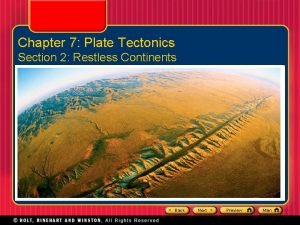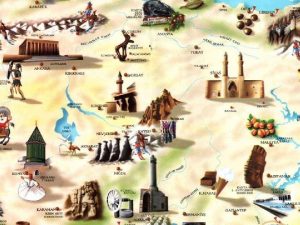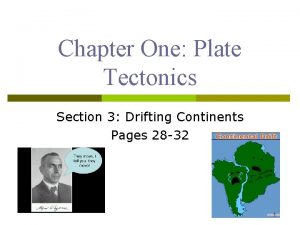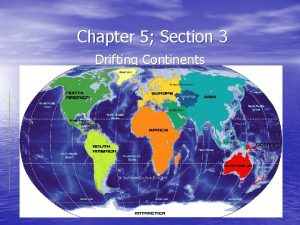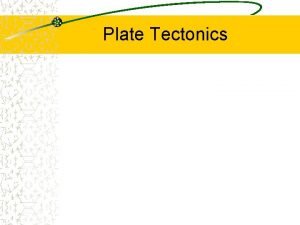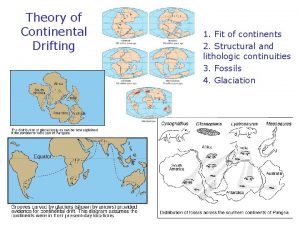Chapter 1 Section 3 DRIFTING CONTINENTS The Theory













- Slides: 13

Chapter 1 Section 3 DRIFTING CONTINENTS

The Theory of Continental Drift, pg. 29 � In 1910 a German scientist named Alfred Wegener formed a hypothesis that the Earth’s continents had moved from their original position. Alfred Wegener

The Theory of Continental Drift, pg. 29 � His hypothesis stated that all the continents had once been joined together in a single landmass and has since drifted apart. � Wegener named this super continent Pangaea, meaning “All Lands. ”

The Theory of Continental Drift, pg. 29 � Pangaea existed about 300 million years ago � Tens of millions of years passed while Pangaea broke apart and slowly moved to their present positions; becoming today’s continents.

The Theory of Continental Drift, pg. 29 � Wegener’s idea that the continents slowly moved over Earth’s surface is now known as continental drift. � Wegener studied landforms, fossils and the changes in Earth’s climate to gather evidence for continental drift. �He published “The Origin of Continents and Oceans” in 1915.

Evidence from Landforms, pg. 30 � Mountain ranges and other features on the continents provided evidence for continental drift. � Mountain ranges in South Africa match up to mountain ranges in Argentina when pieced together. � European coal fields match up with similar coal fields in North America.

Evidence from Fossils � Wegener also used fossils, any trace of an ancient organism that has been preserved in rock, to support his theory. � Fossils of reptiles Mesosaurus and Lystrosaurus have been found in places now separated by oceans. �Neither could have swam great distances across salt water, therefore they must have lived on a single landmass that has since been split apart.

Evidence from Fossils � Glossopteris, a fern-like plant, lived over 250 million years ago. � Fossils have been found in Africa, South America, Australia, India and Antarctica. �The presence on widespread landmasses convinced Wegener that the continents were once connected. �Its seeds were too large to have been carried by the wind, and too fragile to have survived travel by ocean waves.

Evidence from Climate, Pg. 31 � Wegener used evidence of climate change to support his theory of continental drift. � Example: The island of Spitsberger lies in the Arctic Ocean, North of Norway. It is ice-covered and has a harsh polar climate. �But fossils of tropical plants have been found on Spitsberger.

Evidence from Climate, Pg. 31 � When these plants were alive 300 million years ago, the island must have had a warm and mild climate (closer to the equator).

Evidence from Climate, Pg. 31 � Another example: South Africa was once covered with continental glaciers �Today’s climate there is mild and wouldn’t allow glaciers to form. �S. Africa must have been closer to the South Pole during this time.

Evidence from Climate, Pg. 31 � As continents move towards the poles, climate becomes colder. � As continents move towards the equator, climate becomes warmer. � But continents carry, with it, fossils and rocks formed at its previous locations.

Scientists Reject Wegener’s Theory, Pg. 32 � Because Wegener could not identify the cause of continental drift, most geologists rejected his idea from 19201960. � As new evidence surfaces about Earth’s structure, scientists began to reconsider his theory.
 Chapter 19 drifting toward disunion
Chapter 19 drifting toward disunion Chapter 7 section 2 restless continents answer key
Chapter 7 section 2 restless continents answer key Urban drifting
Urban drifting Chapter 4 consciousness
Chapter 4 consciousness Drifting plants
Drifting plants Drifting plants
Drifting plants Drifting toward disunion
Drifting toward disunion Chapter 24 the land where continents collided answer key
Chapter 24 the land where continents collided answer key Continents size order
Continents size order 7 continents in order
7 continents in order An empire across three continents
An empire across three continents The seven continents and their countries
The seven continents and their countries Continent
Continent Which is the largest continent
Which is the largest continent

